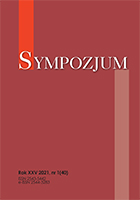Sekwencja „Stabat Mater” we włoskich interpretacjach muzycznych doby XVIII wieku
The Stabat Mater sequence in Italian musical interpretations of the 18th-century
Author(s): Renata BorowieckaSubject(s): Christian Theology and Religion, Fine Arts / Performing Arts, Music, Theology and Religion
Published by: Wyższe Seminarium Misyjne Księży Sercanów
Keywords: Italian music;religious music;the Stabat Mater sequence;18th-century;
Summary/Abstract: The Stabat Mater poem, which describes the suffering of Blessed Virgin Mary under the cross on which Jesus – her Son – is dying, has become a universal theme which inspired composers of various ages and origins and found its expression in numerous musical interpretations. From among over 400 compositions which set the text of the sequence to music, a large proportion are 18th-century works (mostly – late baroque) of Italian provenience. Attempting to interpret a musical composition with text of the 18th century, one has to take into account the theory of affects and musical rhetoric, which make the text dependent on music both on the emotive and symbolic level.The paper will examine the Stabat Mater compositions in the rhetoric context, referring to three main levels: inventio, dispositio and decoratio. The common and individual tendencies will be articulated, evident by the appropriate choice of the key, tempo and rhetorical figures, as well as by some melodic and rhythmic motives or harmonic structure having function of the special illustrative-symbolic signs. The nodal points of the work will be presented as well as the requests of man directed at the Mother (the second part of the sequence) assuming varying intonations of supplication. The function and the message of the compositions are advisable.In contemporary times Stabat Mater of the great composers resound mainly as concert masterpieces in church and secular interiors. The vitality of these interpretations after three hundred years from their creation most certainly bears witness to the composers’ artistry in their works and proves their significance not only for the music of the 18th century but also for the culture and faith of today.
Journal: Sympozjum
- Issue Year: 40/2021
- Issue No: 1
- Page Range: 83-102
- Page Count: 20
- Language: Polish

